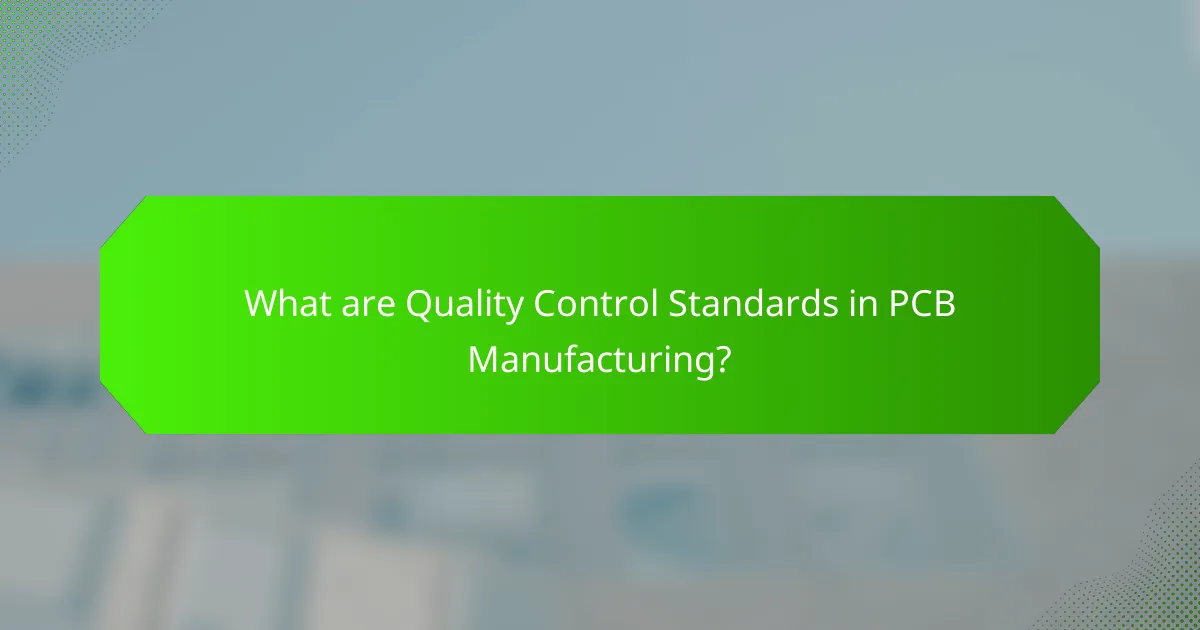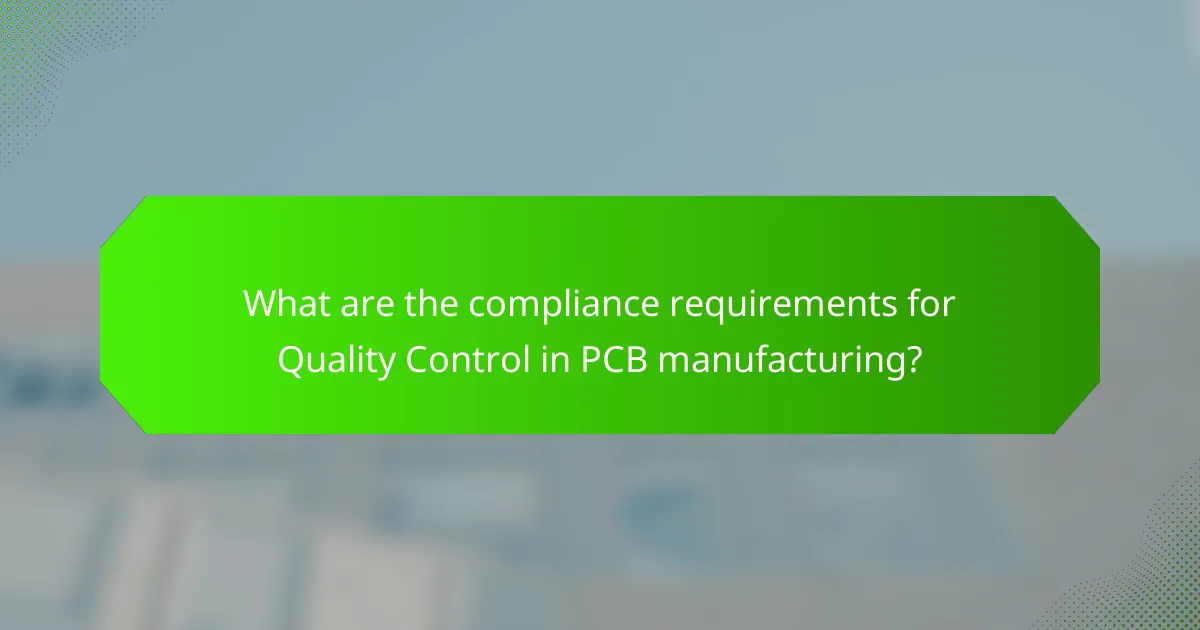Quality control standards in printed circuit board (PCB) manufacturing are essential guidelines that ensure the reliability and performance of PCBs. Key standards include IPC-A-600, which sets acceptance criteria for quality; IPC-6012, detailing requirements for rigid PCBs; and IPC-2221, which provides design standards. The article outlines critical quality control processes such as design review, material inspection, in-process inspection, final inspection, and testing, which collectively help maintain high standards. It also covers various testing methods, including visual inspection, electrical testing, and functional testing, as well as compliance requirements with industry standards like ISO 9001 and RoHS. Adherence to these practices is vital for reducing defects and ensuring product longevity in PCB manufacturing.

What are Quality Control Standards in PCB Manufacturing?
Quality control standards in PCB manufacturing are guidelines that ensure the reliability and performance of printed circuit boards. These standards include IPC-A-600, which specifies acceptance criteria for PCB quality. IPC-6012 outlines requirements for rigid PCBs, while IPC-2221 provides design standards. Compliance with these standards is critical for reducing defects and ensuring product longevity. Regular audits and inspections are necessary to maintain adherence to these quality control measures. These practices help manufacturers meet industry expectations and customer demands for high-quality PCBs.
How do Quality Control Standards impact PCB manufacturing processes?
Quality control standards significantly impact PCB manufacturing processes by ensuring product reliability and performance. These standards dictate the procedures and criteria for quality assurance throughout manufacturing. They establish benchmarks for materials, design, and testing protocols. Compliance with these standards reduces defects and enhances overall product quality. For example, IPC-A-600 sets criteria for the acceptability of printed circuit boards. Adhering to such standards minimizes the risk of failures in electronic devices. Statistical process control (SPC) methods are often employed to monitor production consistency. Studies show that implementing quality control standards can lead to a 30% reduction in manufacturing defects. Thus, quality control standards are essential for maintaining high manufacturing efficiency and customer satisfaction.
What are the key components of Quality Control Standards in PCB manufacturing?
The key components of Quality Control Standards in PCB manufacturing include design verification, material inspection, process control, and final testing. Design verification ensures that the PCB design meets specified requirements. Material inspection involves checking raw materials for compliance with quality standards. Process control monitors manufacturing processes to maintain consistency and quality. Final testing assesses the functionality and reliability of the finished PCB. These components collectively ensure that PCBs meet industry standards and customer specifications.
How do these standards ensure product reliability and safety?
Quality control standards ensure product reliability and safety by establishing strict guidelines for manufacturing processes. These standards outline specific criteria for materials, design, and testing procedures. Compliance with these criteria reduces the risk of defects and failures. Regular audits and inspections verify adherence to these standards. Testing methods such as thermal cycling and electrical testing assess product performance under various conditions. The implementation of these standards leads to consistent quality in PCB manufacturing. Historical data shows that companies adhering to these standards experience fewer product recalls and higher customer satisfaction.
Why are Quality Control Standards essential in PCB manufacturing?
Quality control standards are essential in PCB manufacturing to ensure product reliability and performance. These standards help in identifying defects early in the production process. They establish benchmarks for materials, processes, and finished products. Consistent adherence to these standards reduces the risk of failure in electronic devices. According to IPC-A-600, a widely recognized standard, visual inspection criteria are crucial for assessing PCB quality. Additionally, compliance with ISO 9001 ensures that manufacturers meet international quality management requirements. This leads to improved customer satisfaction and trust in the products. Ultimately, quality control standards safeguard the integrity of electronic systems.
What risks are mitigated by adhering to Quality Control Standards?
Adhering to Quality Control Standards mitigates risks such as product defects, safety hazards, and regulatory non-compliance. Product defects can lead to failures in performance, resulting in costly recalls. Safety hazards can cause injuries or damage to equipment, impacting employee welfare. Regulatory non-compliance can result in fines and legal actions, jeopardizing business operations. A study by the International Organization for Standardization (ISO) indicates that companies implementing quality standards see a 20% reduction in defects. This data underscores the importance of adhering to Quality Control Standards in minimizing these risks effectively.
How do Quality Control Standards influence customer satisfaction?
Quality control standards significantly influence customer satisfaction by ensuring product reliability and performance. When manufacturers adhere to established quality control standards, they minimize defects and inconsistencies in their products. This leads to enhanced product quality, which directly correlates with customer trust and loyalty. According to a study by the American Society for Quality, 85% of consumers are more likely to repurchase from companies that consistently deliver high-quality products. Moreover, effective quality control processes can reduce return rates and customer complaints, further boosting satisfaction levels. In PCB manufacturing, compliance with standards like IPC-A-600 ensures that products meet specific performance criteria, which is crucial for customer confidence.

What are the key processes involved in Quality Control for PCBs?
The key processes involved in Quality Control for PCBs include design review, material inspection, in-process inspection, final inspection, and testing. Design review ensures that the PCB design meets specifications and standards. Material inspection verifies the quality of raw materials before production. In-process inspection monitors the manufacturing process for adherence to quality standards. Final inspection assesses the completed PCB for defects and compliance. Testing evaluates the functionality and reliability of the PCB under specified conditions. These processes collectively ensure that PCBs meet industry standards and customer requirements.
How is the Quality Control process structured in PCB manufacturing?
The Quality Control process in PCB manufacturing is structured through several key stages. First, incoming materials undergo inspection to ensure they meet specified standards. Second, during the production process, in-process inspections are conducted at various stages. These inspections verify that the manufacturing process adheres to quality standards. Third, final testing is performed on completed PCBs to check for defects. This includes electrical testing, visual inspection, and functional testing. Lastly, documentation and traceability are maintained throughout the process. This ensures compliance with industry standards such as IPC-A-600 and IPC-A-610. Quality Control in PCB manufacturing is critical for ensuring reliability and performance in electronic devices.
What are the stages of Quality Control in PCB production?
The stages of Quality Control in PCB production include design review, incoming material inspection, in-process inspection, final inspection, and testing. Design review ensures that specifications meet product requirements. Incoming material inspection checks the quality of raw materials before production. In-process inspection monitors production processes for adherence to standards. Final inspection evaluates the completed PCB for defects. Testing assesses functionality through electrical and mechanical tests. Each stage is critical for ensuring product reliability and compliance with industry standards.
How do these stages contribute to overall product quality?
The stages in PCB manufacturing contribute significantly to overall product quality. Each stage, from design to assembly, ensures that the final product meets specified standards. Rigorous testing during production identifies defects early. This reduces the likelihood of failures in the field. Compliance with industry standards guarantees reliability and safety. Quality assurance measures, such as inspections, validate that each component functions as intended. Statistical process control monitors variations in manufacturing processes. This helps maintain consistency and improves product performance. Collectively, these stages ensure that the PCB meets customer expectations and regulatory requirements.
What role does documentation play in Quality Control processes?
Documentation serves as a critical component in Quality Control processes. It provides a structured framework for recording and tracking quality metrics. Accurate documentation ensures compliance with industry standards and regulatory requirements. It facilitates the identification of defects and non-conformance issues. Moreover, documentation supports continuous improvement initiatives by allowing teams to analyze historical data. It also aids in training new employees on quality standards and procedures. Consistent documentation practices enhance communication among team members. Ultimately, thorough documentation contributes to overall product quality and reliability in PCB manufacturing.
What types of documentation are required for Quality Control in PCB manufacturing?
Quality control in PCB manufacturing requires several types of documentation. These include process control documents, inspection reports, and test data sheets. Process control documents outline the procedures and standards for manufacturing processes. Inspection reports detail the results of visual and functional inspections performed on PCBs. Test data sheets provide quantitative results from electrical and environmental testing. Additionally, quality assurance plans and non-conformance reports are essential. Quality assurance plans define the overall quality objectives and processes. Non-conformance reports document any deviations from specified standards. These documents ensure compliance with industry standards and facilitate traceability throughout the manufacturing process.
How does documentation support compliance with Quality Control Standards?
Documentation supports compliance with Quality Control Standards by providing a structured framework for recording processes and outcomes. It ensures that all quality control procedures are consistently followed and verified. This consistency is crucial for maintaining high standards in PCB manufacturing. Documentation includes specifications, testing results, and corrective actions taken. These records serve as evidence during audits and inspections. Regulatory bodies often require documented proof of compliance to verify adherence to established standards. Furthermore, well-maintained documentation facilitates training and knowledge transfer among employees. It helps identify areas for improvement by analyzing historical data. This comprehensive approach strengthens overall quality assurance efforts in PCB manufacturing.

What testing methods are used in Quality Control for PCBs?
Visual inspection, electrical testing, and functional testing are common methods used in Quality Control for PCBs. Visual inspection checks for physical defects like soldering issues and component misalignments. Electrical testing verifies circuit integrity and functionality through methods such as in-circuit testing (ICT) and flying probe testing. Functional testing assesses the PCB’s performance under operational conditions to ensure it meets specifications. These methods are essential for identifying defects and ensuring product reliability in PCB manufacturing.
What are the common testing methods employed in PCB Quality Control?
Common testing methods employed in PCB Quality Control include visual inspection, electrical testing, and functional testing. Visual inspection involves examining the PCB for physical defects such as soldering issues or component misalignment. Electrical testing assesses the electrical functionality of the PCB, ensuring that circuits are complete and components are functioning correctly. Functional testing evaluates the PCB’s performance in real-world conditions, confirming that it meets design specifications. These methods are essential for maintaining quality and reliability in PCB manufacturing.
How do visual inspections contribute to Quality Control?
Visual inspections are a critical component of Quality Control in PCB manufacturing. They help identify defects and inconsistencies in printed circuit boards. This process allows for immediate feedback on production quality. Visual inspections can detect issues such as soldering errors, component misalignment, and surface defects. Research indicates that approximately 70% of defects can be identified through visual methods. This contributes to reducing rework and scrap rates. Moreover, visual inspections support compliance with industry standards. They ensure that products meet specified quality criteria before further testing or shipment.
What is the significance of electrical testing in PCB Quality Control?
Electrical testing is crucial in PCB quality control as it ensures functionality and reliability. This testing verifies electrical connections and identifies defects early in the manufacturing process. It helps in detecting issues like short circuits, open circuits, and incorrect component placements. Implementing electrical testing can reduce the risk of product failure in the field. Studies show that effective electrical testing can decrease warranty claims by up to 30%. Consistent testing aligns with industry standards, enhancing overall product quality. Therefore, electrical testing is an essential component of PCB quality control.
How do advanced testing methods enhance Quality Control in PCB manufacturing?
Advanced testing methods enhance Quality Control in PCB manufacturing by increasing defect detection and improving reliability. These methods include automated optical inspection (AOI), X-ray inspection, and electrical testing. AOI quickly identifies surface defects, such as solder joint issues, with high accuracy. X-ray inspection allows for the examination of internal features, ensuring proper component placement and solder integrity. Electrical testing verifies functionality and performance of the PCB before it is deployed. These testing techniques collectively reduce the risk of failures in the final product. According to a study published in the Journal of Electronic Testing, the implementation of advanced testing methods can reduce defects by up to 30%. This significant improvement in defect detection leads to enhanced overall product quality and customer satisfaction.
What role do automated testing systems play in Quality Control?
Automated testing systems are crucial in Quality Control for PCB manufacturing. They enhance accuracy and efficiency in testing processes. These systems perform repetitive tasks with high precision. They minimize human error during inspections. Automated systems can conduct tests such as Automated Optical Inspection (AOI) and In-Circuit Testing (ICT). These methods ensure that defects are identified early in the production process. Studies show that automation can reduce testing time by up to 50%. This leads to faster production cycles and improved product reliability. Overall, automated testing systems significantly contribute to maintaining high-quality standards in PCB manufacturing.
How does statistical process control improve the testing process?
Statistical process control (SPC) improves the testing process by enabling real-time monitoring and control of manufacturing processes. It utilizes statistical methods to analyze data collected from testing phases. This analysis helps identify variations that may indicate defects or inefficiencies. By establishing control limits, SPC allows for the detection of trends before they lead to failures. Implementing SPC can lead to a reduction in waste and rework, enhancing overall product quality. Research shows that companies using SPC have reported up to a 50% reduction in defects. This data-driven approach ensures that testing processes are both efficient and effective.

What are the compliance requirements for Quality Control in PCB manufacturing?
Compliance requirements for Quality Control in PCB manufacturing include adherence to industry standards such as IPC-A-600 and IPC-6012. These standards define the acceptability of printed circuit boards and their performance criteria. Manufacturers must also comply with ISO 9001, which outlines quality management systems. Additionally, RoHS compliance is essential, ensuring that PCBs do not contain hazardous substances. Regular audits and inspections are required to verify compliance with these standards. Documentation of quality control processes and test results must be maintained for accountability. Compliance with these requirements ensures product reliability and safety in various applications.
What regulations govern Quality Control Standards in PCB manufacturing?
Quality Control Standards in PCB manufacturing are governed by several regulations. The most prominent regulations include IPC standards, particularly IPC-A-600 and IPC-A-610. IPC-A-600 specifies the acceptability of printed boards, while IPC-A-610 outlines the acceptability of electronic assemblies. Additionally, ISO 9001 certification is often required, focusing on quality management systems. RoHS compliance is also crucial, addressing hazardous substances in electronic products. These regulations ensure that PCBs meet safety, reliability, and performance criteria in manufacturing processes. Compliance with these standards is essential for market acceptance and regulatory approval.
How do international standards affect local PCB manufacturers?
International standards significantly impact local PCB manufacturers by establishing benchmarks for quality and safety. Compliance with these standards is essential for market access and competitiveness. For example, adherence to IPC standards ensures that PCBs meet industry requirements for reliability. Additionally, international standards can drive innovation by encouraging manufacturers to adopt advanced technologies and processes. These standards also facilitate trade by harmonizing requirements across borders. Consequently, local manufacturers often invest in training and equipment to meet these standards, which can enhance their operational efficiency. Overall, international standards shape the operational landscape for local PCB manufacturers, influencing their practices and market opportunities.
What certifications can PCB manufacturers obtain for compliance?
PCB manufacturers can obtain several certifications for compliance. Common certifications include ISO 9001, which ensures quality management systems are in place. IPC-A-600 focuses on the acceptability of printed circuit boards. IPC-6012 addresses the performance specifications for rigid PCBs. UL certification indicates compliance with safety standards for electrical components. RoHS compliance ensures products are free from hazardous substances. Each certification demonstrates adherence to specific industry standards and regulations. These certifications help manufacturers meet customer expectations and regulatory requirements.
How can manufacturers ensure ongoing compliance with Quality Control Standards?
Manufacturers can ensure ongoing compliance with Quality Control Standards by implementing a systematic approach to quality management. This includes regular audits to assess adherence to established standards. Training programs for employees on quality control procedures are essential. Manufacturers should also utilize statistical process control to monitor production quality continuously. Documentation of all quality processes and results is crucial for accountability. Additionally, adopting industry-specific certifications can reinforce compliance. For example, IPC standards provide guidelines for PCB manufacturing quality. Continuous improvement practices, such as feedback loops and corrective actions, help maintain compliance over time. These strategies collectively ensure that manufacturers meet and uphold quality control standards effectively.
What best practices should manufacturers adopt for continuous compliance?
Manufacturers should adopt a proactive compliance management system for continuous compliance. This system includes regular audits to assess adherence to standards. Training employees on compliance requirements is essential. Documentation of processes and changes ensures traceability. Utilizing technology for real-time monitoring can enhance compliance tracking. Engaging with regulatory bodies keeps manufacturers updated on changes. Establishing a culture of quality within the organization promotes accountability. These practices help maintain compliance and reduce risks associated with non-compliance.
How do audits and inspections support compliance efforts?
Audits and inspections support compliance efforts by systematically evaluating adherence to established regulations and standards. They identify gaps in processes that may lead to non-compliance. Regular audits help organizations maintain quality control by ensuring that all operations meet industry benchmarks. Inspections provide real-time assessments of manufacturing practices, which can prevent potential violations. Both processes create accountability and foster a culture of continuous improvement. They also generate documentation that can be critical during regulatory reviews. Furthermore, compliance with standards can lead to reduced risks and improved product quality.
What are the best practices for implementing Quality Control Standards in PCB manufacturing?
Implementing Quality Control Standards in PCB manufacturing requires systematic practices. Begin by defining clear quality objectives and compliance requirements. Establish a robust quality management system to oversee processes. Regular training for staff ensures adherence to standards. Conduct frequent inspections and testing throughout production stages. Utilize statistical process control to monitor variations. Document all quality control procedures for traceability. Finally, perform regular audits to identify areas for improvement. These practices enhance product reliability and customer satisfaction in PCB manufacturing.
Quality Control Standards in PCB Manufacturing are essential guidelines that ensure the reliability and performance of printed circuit boards. The article covers key components of these standards, including design verification, material inspection, and various testing methods such as visual and electrical testing. It also discusses compliance requirements with industry standards like IPC-A-600 and ISO 9001, highlighting the importance of regular audits and documentation in maintaining quality. Additionally, the article emphasizes how adherence to these standards mitigates risks, enhances customer satisfaction, and contributes to overall product quality in PCB manufacturing.


